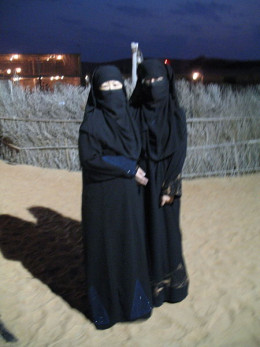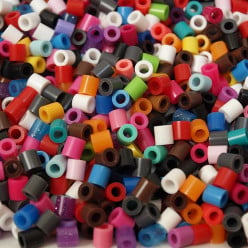What’s the rationale most Muslim women dress in black Jilbabs/Burqas and men in
What’s the rationale most Muslim women dress in black Jilbabs/Burqas and men in white loose robes?

- Old Empresarioposted 12 years ago
0
First off, the Burqa is a very rare garment that is worn in extremely repressive cultures, like those in Afghanistan. Few countries use it and Americans who think we should continue to be involved in the Middle East need to understand that calling the garment pictured above a "burqa" is like referring to a suit-and-tie as a “sweater”. It's simply not correct.
A hijab of the abaya and niqab are far more common in the Arab world. Their rationale for doing this ostensibly comes from the Quran, which calls for women to dress modestly. But the full covering is a phenomenon particular to the Arab culture, which has made women wear them long before Islam was created in the 7th Century AD. Long story short, it’s their old and smelly tradition to wear these. There are extremists that think women should be covered head to toe and there are moderate Moslems that don’t think it’s necessary for a woman to cover her head. It’s sort of like the Quakers or Mennonites versus mainstream Christians, except that the mainstream Christians are looser and more liberal with women’s rights and mainstream Moslems think women should at least cover their hair.I find it interesting that you did not mention how some orthodox women of the Jewish faith within Israel are wearing head to toe coverings as well, most often called burkas in the US.
I think when the word travels from one culture to another, it becomes precisely IT = "suit-and-tie" could be called "sweater". I am always bewildered how "babushka" came to mean a head scarf whereas it means "an old woman" or "grandma".
It was introduced as a way for men to control their women and protect them from the uncontrolable desires of other men. Sort of like the chastity belt of early Europe.They put it into religious practices knowing that men would obey the moral guidence of God/Allah over the desires of men.
Today women accept it as a way to build self discipline and obediance to faith and family tradition. They also know that it is a statement against western ideology. Some don't like it, which is a natural human tendancy to rebel against authority but most see it as an obedience to culture.
Those who see it as a prison for women and want to try to free them from what they percieve to be a backward and primitive practice maybe making a mistake. Thge only way to change it is to change the ideology of the religion. Good luck with that.- HowIConqueredposted 12 years ago
0
I'm assuming your asking about the color significance and not the style. Honestly I have no clue. It would seem more comfortable (during the warm months) if the women could change the colors, but I guess that goes against the modesty aspect.
I've heard a couple reasons why. Two of the stories stand out. One story, was about an Arabian ruler who fell in love with a beautiful woman and she decided to hide her beauty from the rest of the world, only he could see her.
The second one, I was in Qatar on a deployment. Part of my duties required me to go downtown Doha and escort troops on R&R from Iraq to different attractions. As a guy, I had strict rules to not speak with the women but one of my female counterparts went up to one and asked why they wore it, it must have been really hot. The woman responded "I wear it because it's hotter in hell".
As for the men, it's practical. I was studying Arabic when I first enlisted and I ordered a dishdasha (a male robe) from a company in Kuwait. It's surprisingly comfortable, cool, and the reason for the long sleeves is it protects your skin from the sun. It helped out the couple times I wore it while I was in California, so I can only Imagine it is perfect for the Middle East.
Related Discussions
- 12
Just curious to know the logic - Why do Muslim women wear the veil, whereas Musl
by Shil1978 13 years ago
Just curious to know the logic - Why do Muslim women wear the veil, whereas Muslim men don't?
- 147
Fatwa to working Muslim women
by pisean282311 15 years ago
The largest Muslim seminary in India, Darul Uloom of Deoband, has issued a fatwa against working Muslim women, saying working with men is not Islamic. The fatwa says it is unlawful for Muslim women to do any job in government or private institutions that entails men and women working together and...
- 30
Why do Muslim women have no respect for themselves
by RealityTalk 12 years ago
Why do Muslim women have no respect for themselvesNow, I'm positive I will receive angry comments from Muslim men - & Muslim women in response to this question. Most likely replying they do have respect for themselves. I mean no disrespect, but to a man raised in a society where...
- 13
What do you know about the hijab؟
by Ahmed Med 12 years ago
What do you know about the hijab؟Beauty is a gift from God, is it necessary to hide some of it in order to serve the community?
- 64
Niqab or not niqab that is the question?
by karl 12 years ago
There is at the moment another debate going on in the UK about the wearing of the niqab, it seems that freedom only goes so far when its against ancient oppression. The niqab has nothing whatsoever to do with freedom or choice. The drive for its acceptance comes from male hardliners who have no...
- 4
What can Muslim women do while they are on their menses? Can they still read the
by muslimah stanley 14 years ago
What can Muslim women do while they are on their menses? Can they still read the Quran?












